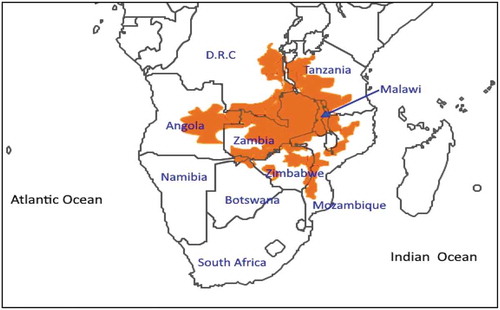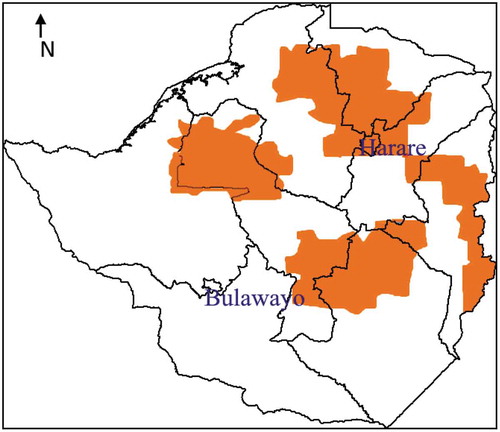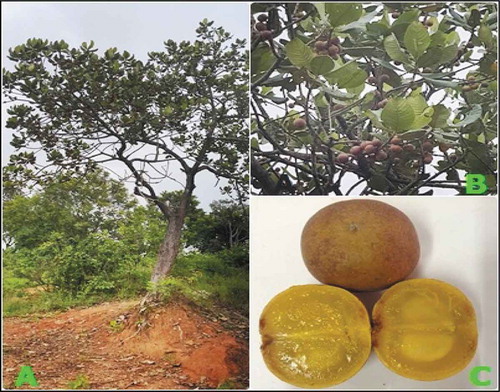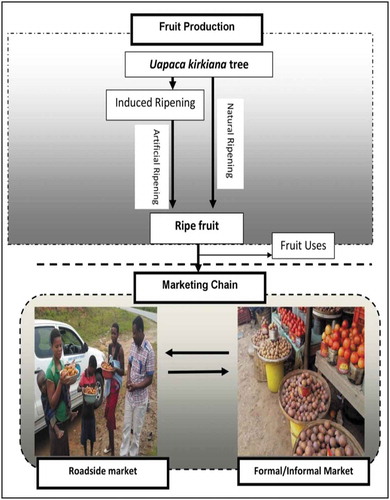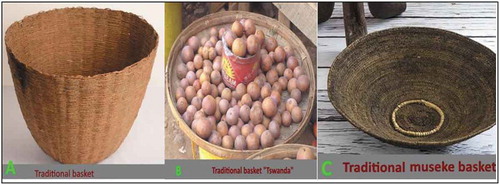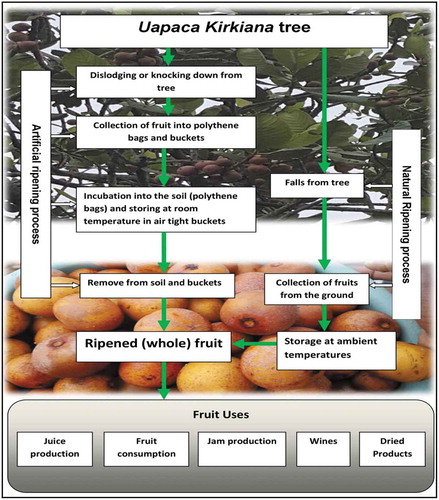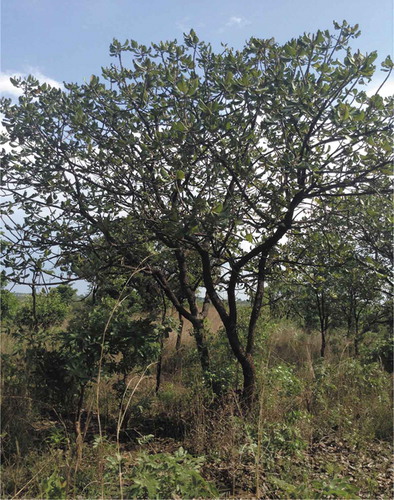Abstract
Uapaca kirkiana is an indigenous fruit tree that grows in hot and dry areas in sub-Saharan Africa. The tree tolerates dry conditions, high temperatures and acts as a food source for people that live in drier conditions were exotic fruit trees can hardly survive. The tree produced fruits that are rich in essential minerals and has a potential to act as a source of vitamin C. Ripe fruits are eaten raw and mostly sold at local and roadside markets with no processing. Traditionally the fruit can be processed into various products which include alcoholic and non-alcoholic beverages and traditional cakes. The fruit has a potential to improve nutritional status, food security, and livelihoods of rural dwellers especially in arid and semi-arid areas. However, the contribution of the fruit to human nutrition is often not recognised. The fruit, like most indigenous fruits, has limited and out-dated data on nutrient composition. Indigenous knowledge on handling and uses of the fruit needs to be upgraded. This review attempts to contribute to this effort by evaluating the existing evidence on its nutritional potential, functional and bioactive properties, processing, postharvest handling with the aim of identifying possible areas of research and its utilisation.
PUBLIC INTEREST STATEMENT
Sub-Saharan Africa region consists of many but different species of fruits that have adapted to different climatic conditions. Fruits are good sources of essential micronutrients in the diet. However, there is limited of scientific knowledge on nutritional composition and benefits of most indigenous fruits. Furthermore, sub-Saharan Africa has the most nutritionally insecure people, especially children and women who suffer from hidden hunger. Food insecurity at most rural households is approximately over 30%. At the same time, there is high rate of malnutrition and micronutrients deficiency in sub-regions, especially Southern Africa due to limited access to food and utilization of fruits. Many processing technologies have been developed to add value in quality, mineral bioaccessibility, shelf life and postharvest handling on fruits. The utilisation of indigenous fruits in the production of functional foods has great potential to improve nutrition, and help mitigate mineral deficiency problems in most rural communities in sub-Saharan Africa.
Competing interest
The authors declare no competing interest.
1. Introduction
Mineral undernutrition, particularly iron and zinc deficiencies have been reported to be the prevalent nutritional problems worldwide (Platel & Srinivasan, Citation2016). Sub-Saharan Africa is a home to some of the most nutritionally insecure people in the world; notably, women and children suffer from insufficient intake of protein and energy, and lack of micronutrients (Stevens et al., Citation2012; World Health Organization [WHO], Citation2017). A WHO report (WHO, Citation2015) states that iron deficiency is the most common micronutrient deficiency that affects over 30% of the global population with women and children representing a greater percentage of effected individuals in developing nations. In sub-Saharan Africa, especially in Zimbabwe, the prevalence of stunting was 26% in 2018 and it remains above the acceptable global threshold of 20% (National Nutritional Survey [NNS], Citation2018). Consumption of indigenous fruits has a great potential to improve nutrition and help to mitigate against mineral deficiencies problems in most rural communities in sub-Saharan Africa.
Indigenous fruits are mainly used to supplement the diet by many rural folks in sub-Saharan Africa (Akinnifesi et al., Citation2004; Bille et al., Citation2013; Legwaila et al., Citation2011; Mithöfer & Waibel, Citation2003; Mpofu et al., Citation2014; Nhukarume et al., Citation2010; Saka et al., Citation2004). Consumption of wild fruits such as Uapaca kirkiana is important amongst the poor and vulnerable groups in the community (Cunningham, Citation2002; Maghembe et al., Citation1998; Tiisekwa et al., Citation2004) because they cannot afford to buy food to feed themselves. More so, Mander and Le Breton (Citation2006) and Garrity (Citation2004) reported that 80% of the rural population in sub-Saharan Africa depend on traditional plants for medicinal use as a form of primary health care. The Plant for a future (pfaf) (Citation2020) and Orwa et al. (Citation2009) have reported a traditional medicinal claim on the potential use of U.kirkiana roots, bark, and leaves in the treatment of stomach-ache and dysentery.
U. kirkiana is closely related to other species such as U. bengelensis, U. nitida, U. pilosa, and U. robynsii, which are not commonly found in Zimbabwe (Ngulube, Citation1996) but found in other areas of Southern Africa (Figure ).
U. kirkiana tree is mainly distributed in semi-dry and dry areas although it can grow in some relatively wet areas of Zimbabwe (Figure ). The species, U. kirkiana (Figure ) is one of the most dominant and abundant wild fruit tree found in Zimbabwe (Kadzere et al., Citation2001). It produces fruits that ripen during the period October to February (Figure ).
The fruit is known by different names from different locations and countries; wild loquat (English), msuku/nkusu in Malawi, Tanzania, and Zambia, and mahobohobo or mazhanje in Zimbabwe (Akinnifesi et al., Citation2004). The fruit is oval shaped (Figure ), and contains seeds and a yellowish pulp (Moombe et al., Citation2014). Unripe fruits usually have a relatively sour taste (Kadzere et al., Citation2001). The ripe fruit has a sweet taste (Maroyi, Citation2014; Mithöfer & Waibel, Citation2003). Traditional foods (wild fruits) of sub-Saharan Africa have a history of being safe and nutritious and affordable (Mpofu et al., Citation2014). Wild loquat fruit can produce a pulp yield of 28.6% of total fruit weight (Ndabikunze et al., Citation2010). Domestication of the fruit tree can therefore be suggested (Katsvanga et al., Citation2007; Maghembe et al., Citation1993; Mwamba, Citation1988).
Data on the multipurpose Uapaca kirkiana fruit tree has been published by other authors (Akinnifesi et al., Citation2004; Ngulube, Citation1996). A review on U.kirkiana fruit tree by Ngulube (Citation1996) focused on the taxonomy, tree propagation and resource potential in food, wood and medicinal uses. Furthermore, Plant for a future (pfaf) organisation database (Plant for a future [pfaf], Citation2020) has similar data on cultivation, edible uses (Facciola, Citation1998; Karalliedde & Gawarammana, Citation2008), medicinal (Ecocrop database, Citation2020), and agroforestry uses (World Agroforesty Centre, Citation2020) of U. kirkiana fruit tree. This review is aimed at providing more data and information on U. kirkiana fruit by evaluating the nutritional potential, functional and bioactive properties, postharvest handling and traditional uses, fruit marketing, and identifying possible research gaps on the fruit.
2. Nutritional composition of U. kirkiana fruit pulp
Macronutrient composition of U. kirkiana fruit compares well with other wild fruits from sub-Saharan Africa as shown in Table .
Table 1. Nutritional composition of some indigenous fruits of Southern Africa per 100 g EP
2.1. Carbohydrates
The fruit has a total carbohydrate content that range from 28.7 to 92 g/100 g edible portion (EP) (Ngulube, Citation1996), which is greater than that found in other wild fruits such as Ziziphus mauritiana and Irvingia edulis. In a study by Saka and Msonthi (Citation1994), the whole fruit was found to contain 86.5% total carbohydrate, 8.4% fibre, 1.1% fat, 1.8% crude protein, and 27.4% dry matter.
A review by Sufi and Kaputo (Citation1977) on specific sugars noted that U. kirkiana fruit contains 41 g/100 g glucose, 27 g/100 g fructose, 15 g/100 g sucrose, 2 g/100 g xylose, and traces of galactose, raffinose, and ribose. These sugar levels are higher than those of tropical fruits such as apples, which were found to contain 5.7 g/100 g fructose, 0.6 g/100 g glucose, and 0.57 g/100 g sucrose (Ngadze et al., Citation2017). Studies by Ngulube (Citation1996), and Malaisse and Parent (Citation1985) reported that related species of U. kirkiana had a carbohydrate content of 89 g/100 g, 82.9 g/100 g, 88.3 g/100 g, and 91.2 g/100 g for U. bengelensis, U. nitida, U. pilosa, and U. robynsii species, respectively. These observations explain the fact that other related species of U. kirkiana have a relatively same carbohydrate content found on other wild fruits found in the sub-Saharan Africa such as Adansonia digitata and Tamarindus indica.
A review on carbohydrate data indicated that U. kirkiana fruit has a higher carbohydrate content (28.7 g/100 g EP) as compared to that of most tropical fruits as shown in Table . Furthermore, U. kirkiana fruit compares well in energy provision and has a high caloric value of 523 Kcal/KJ. Ngulube et al. (Citation1996) reported energy values of 13,780 KJ/kg, 14,200 KJ/kg, 14,620 KJ/kg, 14,820 KJ/kg, and 14,620 KJ/kg in U. bengelensis, U. kirkiana, U. nitida, U. pilosa, and U. robynsii, respectively. In a comparative study by Stadlmayr et al. (Citation2013) the U. kirkiana fruit had high energy values of 523 Kcal kJ-1, which was higher than that of Ziziphus mauritiana (184 Kcal kJ−1), Vitex doniana, (474 Kcal kJ−1), and Irvingiaga bonensis, (364 Kcal kJ−1). This suggests U. kirkiana fruit is a relatively excellent source of energy as compared to other tropical fruits, such as apples, oranges, and mangoes.
Table 2. Comparison of the nutritional content per 100 g edible portion (EP) of selected tropical fruits and Uapaca kirkiana
2.2. Protein
Protein content data amongst the major indigenous fruits of sub-Saharan Africa indicates that U. kirkiana fruit has a protein content range of 0.3 g/100 g EP to 0.9 g/100 g EP (Jones et al., Citation2006; Ngulube, Citation1996). Furthermore, Malaisse and Parent (Citation1985) reported a protein content of 0.8 g/100 g for U. nitida and 0.4 g/100 g for U. kirkiana. This low protein content data on U. kirkiana fruit explains that the fruit cannot be used as a protein source, rather protein supplement can be found on other wild fruits such as Adansonia digitata.
2.3. Fat
The fat content in U. kirkiana fruit was noted to be as high as 1.1 g/100 g EP (Saka et al., Citation1992). The fat content is higher as compared to data recorded by other authors and amongst other indigenous and tropical fruits as shown in Tables and . The fat content in all the indigenous fruits shown in Table are not significantly different (p < 0.05) using least significant difference (LSD) test on the means. However, the U. pilosa species has the highest fat content of 3.4 g/100 g (Malaisse & Parent, Citation1985; Ngulube, Citation1996). There is need to verify such data on the fat content of the fruits using modern analytical method.
2.4. Dietary fibre
The dietary fibre content of U. kirkiana fruit is indicated in Table . Dietary fibre intake reduces the risk of stroke (Steffen et al., Citation2003; Whelton et al., Citation2005), hypertension (Anderson, Citation2004; Keenan et al., Citation2002; Montonen et al., Citation2003), diabetes (Birketvedt et al., Citation2005; Lairon et al., Citation2005), and obesity (Brown et al., Citation1999; Watzl, Girrbach, & Roller, Citation2005), and potentially improves the immune system (Schley & Field, Citation2002). The relatively high fibre content in the edible portion of the fruit could be explained with the reported higher micronutrient contents (Table ). Stadlmayr et al. (Citation2013) noted an ash content of 3.2 g/100 g EP in U.kirkiana fruit. This ash content is relatively high in comparison to the data reported by other authors in Table . The fruit has an ash content that was comparable to that of Ziziphus mauritiana and Irvingia edulis.
2.5. Water content (Moisture)
Comparative studies on the water content showed that U. robynsis, a related species of U. kirkiana has the highest water content of 83.0 g/100 g (Ngulube et al., Citation1996). Findings from literature indicate that fresh U. kirkiana fruit has a water content of more than 50%, suggesting a high water activity in the fruit, which can affect its microbiological activity, shelf life, and storage quality.
2.6. Mineral content
The mineral content of U. kirkiana fruit and other indigenous fruits are shown in Table . From the reviewed mineral content data presented in Table , it is evident that U. kirkiana fruit can be used as an important source of iron and zinc because its iron content (11.8 mg/100 g EP) is higher than that in most indigenous fruits and its zinc content shows a no significant difference (p < 0.05) with respect to wild fruits when an LSD test was used.
Table 3. Comparative mineral content of selected indigenous fruits of Southern Africa
A comparative analysis of mineral content of U. kirkiana to tropical fruits revealed that U. kirkiana is an excellent source of iron, zinc, magnesium, and sodium, as shown in Table . This makes the fruit a potential source of essential minerals and can be used to improve iron and zinc nutrition upon consumption of the fruit. However, in terms of nutrition, it is not just enough to determine the total mineral content; it is therefore important and necessary to determine the bioaccessibility of these minerals. Minerals are important for the normal functioning of an organism. Barros et al. (Citation2012) noted that minerals such as iron, calcium, zinc, copper, sodium, potassium, magnesium, boron, manganese, and sulphur were present in the fruit pulp and peel of citrus fruits and this compares well with most wild fruits found in sub-Saharan Africa as shown in Table .
Table 4. Comparison of mineral content of selected exotic fruits and Uapaca kirkiana per 100 g EP
No research has been conducted on the mineral bioaccessibility of U. kirkiana fruit. Therefore, there is a need to carry out more mineral assays and to ascertain their bioaccessibility and/or bioavailability in the human body upon consumption. Estimates of the contribution of the fruit pulp on recommended daily allowances were calculated per consumption of 100 g of the served fruit. The calculation has indicated that U.kirkiana fruit pulp can be able to deliver more than 100% of the RDA for iron in age groups 1–9 years and 9–13 years (Table ). This further supports the importance of the fruit as a good source of iron.
Table 5. U. kirkiana composition with recommended dietary allowance (RDA) and adequate intake (AI) for children (1–9 yrs), children (9–13 yrs), adolescents (14–18 yrs), pregnant females (all ages)
2.7. Ascorbic acid (Vitamin C)
Vitamin C content studies revealed that U. kirkiana fruit has an ascorbic acid content of 14.5 mg g−1 (Stadlmayr et al., Citation2013), while Saka and Msonthi (Citation1994) reported a vitamin C content of 16.8 mg/100 g of fresh fruit. In a study by Ndabikunze et al. (Citation2010) on vitamin C and mineral contents of indigenous fruits of the Miombo woodlands of Tanzania, U. kirkiana fruit pulp had a vitamin C content of 20.8 mg/100 g, which was lesser than that of V. mombassae (41 mg/100 g) fruit. The WHO (Citation1999) reported that the daily body requirement of vitamin C is between 45 mg to 80 mg. Consuming 247 mg of vitamin C daily improves iron absorption by 35% (Cook & Reddy, Citation2001). Therefore, the U. kirkiana fruit can aid in iron absorption because of its relatively high vitamin C content.
3. Functional properties of the fruit
U. kirkiana fruit has a relatively high pulp yield of 283.4 ± 3.91 g kg−1, compared to S. berrea (161.9 ± 1.97 g kg−1), A. digitata (202.4 ± 4.4 g kg−1), and V. mombassea (186.0 ± 4.59 g kg−1) (Ndabikunze et al., Citation2010). Ndabikunze et al. (Citation2010) also noted that U. kirkiana fruit pulp has a high total soluble solids (TSS) content of 169 ± 0.14 g kg−1 as compared to S. berrea (133.0 ± 0.19 g kg−1), A. digitata (116.3 ± 0.16 g kg−1), and V. mombassea (123.3 ± 0.16 g kg−1). The results for TSS values obtained by Ndabikunze et al. (Citation2010) of the U. kirkiana fruit were in agreement with values found for mangoes (140 g/100 g) by Soloviev et al. (Citation2004). This suggests the potential use of the fruit as an ingredient in jam and juice production.
Ndabikunze et al. (Citation2010) noted that U. kirkiana pulp possessed a pH value of 4.67 ± 0.04. The pH values of the fruit pulp observed by Ndabikunze et al. (Citation2010) are higher as compared to pH range 3.0–3.5 which is recommended for jam and juice making. This explains that when using the fruit in jam or juice processing, the pH must be balanced with the addition of other ingredients. The mean total titratable acidity (TTA) of the fruit pulp was 0.5 ± 0.02 g kg−1 (Ndabikunze et al., Citation2010). The acid content of ripe fruit pulp affects the biotransformation of nutrients during processing and product stability in juices. Therefore, there is need to improve the acid levels when processing the U. kirkiana in juice processing (FAO, Citation1999).
4. Bioactive compounds
U. kirkiana fruit contains tannins, which gives it an astringent taste (Muchuweti et al., Citation2006). Tannins reduce blood pressure, speed up blood clotting, reduce serum lipid levels, and adjust immune responses (Bele et al., Citation2010). For example, in wine, tannins exhibit potent antioxidant effects against low-density lipoprotein (LDL) (Bele et al., Citation2010). Muchuweti et al. (Citation2006) reported that ripe and unripe sun-dried U. kirkiana pulp had tannin concentrations of 2 mg/100 g and 2.5 mg/100 g, respectively.
Golding et al. (Citation1998) reported that the biochemical events that occur during the ripening of banana involve the conversion of starch into sugars, flesh softening, and aroma development (Gross et al., Citation1976), and in some cases, tannin biotransformation by UV light produces bioactive metabolites. The embryo part of the U.kirkiana fruit has the highest tannin concentration of 4.5 mg/100 g (Muchuweti et al., Citation2006). Flavonoid concentration was found to be 40 mg/100 g and 30 mg/100 g in sun and oven-dried pulp samples, respectively (Muchuweti et al., Citation2006). Flavonoids are non-nutrient, bioactive compounds (Harnly et al., Citation2006) that are absent in the fruit flesh (Aherne and O’Brien, Citation2002), and help to inhibit the oxidation of low-density lipoproteins (LDL) cholesterol (Chen et al., Citation2007; El-Sayed et al., Citation2006; Hollman et al., Citation2010; Huxley & Neil, Citation2003; Rapizzi et al., Citation2004).
5. Fruit processing
Over the years, the U. kirkiana fruit has been mostly eaten fresh, but is sometimes processed into juices, squashes, wines, sweet beer, porridge, jams (Figure ), and cakes (Ngulube et al., Citation1995). The fruit is used for the production of Masuku, a local brew in Zambia (Muchuweti et al., Citation2006). Furthermore, there is no evidence of commercial processing of the fruit in Zimbabwe. Processing of fresh fruit is necessary because of the high rate of fruit perishability. Production of U. kirkiana juice involves cutting the fruit skin, pulping the crude mixture in a mortar and pestle, sieving it through an 800 μM sieve, diluting the pulp with cool boiled water, adding sucrose and preservatives, pasteurising at 90°C for 15 min, and cooling and storage (25–32°C) (Ndabikunze et al., Citation2010).
Pasteurisation reduced the vitamin C content in U. kirkiana fruit juice by 55% (from 4.5 ± 0.324 to 2.1 ± 0.330 mg/100 g) (Ndabikunze et al., Citation2010). The observed loss in vitamin C levels was attributed to the high pasteurization temperatures (Cradall et al., Citation1990). During juice storage, the vitamin C content decreased significantly (by 40%) with time. The same trend was observed in citrus fruits (Kadzere et al., Citation2006). However, despite the reported decrease in the vitamin C content over time, the vitamin C content of U. kirkiana juice was within the allowed amounts recommended for an adult (60 mg per day, Lutham, Citation1997). It is important to note that most households are unaware of the new processing technologies that may be suitable to meet their needs. Most people rely on their indigenous knowledge systems of processing the fruit at a household level. In addition, there is a need to upgrade and improve the processing techniques. Tiisekwa et al. (Citation2004) recommended that if households are trained on good processing methods in their locality, the fruit could be better processed for home consumption, even at a commercial level.
6. Sensory qualities
Moombe et al. (Citation2014) reported that U. kirkiana was the most preferred indigenous fruit and had an overall mean ranking score of 3 out of 5 in Zambia. In Malawi, the fruit was most preferred because of its sweetness and nutritional value (Campbell et al., Citation1997; Haq et al., Citation2008; Ngulube et al., Citation1995; Ntupanyama et al., Citation2008; Saka et al., Citation2008). Ntupanyama et al. (Citation2008) reported the fruit was liked for the following parameters: preference level of sweetness (38%), vitamins (23%), snack value (18%), hunger satisfaction (16%), leisure/habit (3%), and thirst quenching (2%). Consumers regarded taste, cleanliness and flavour as major indicators on which to base their liking of the fruit (Ramadhani & Schmidt, Citation2008). Studies indicated that 55% of the consumers selected the fruit based on taste, while 32% selected the fruit based on fruit colour (Ntupanyama et al., Citation2008).
Jam made from the fruit had a higher mean acceptance score of 4.0 out of 5, as compared to that of Strychnos cocculoides fruit jam (Saka et al., Citation2007). Juices made from U. kirkiana had a higher colour score of 5.36 as compared to those of V. mombassea (4.56), S. berrea (4.63), and A. digitata (4.87) fruits (Ndabikunze et al., Citation2010).
7. Fruit marketing
U. kirkiana fruit collectors, retailers and vendors usually collect the fruits for selling from naturally grown forests near their homes, and very few people collect the fruits from trees at their homesteads. The marketing system of the fruits is not characterized by a clear separation of marketing activities. This is because anyone can become a fruit collector, a vendor and a consumer at the same time thereby making it difficult to identify the fruit collectors who sale to vendors, identify vendors who then sale to consumers. Fruit collectors tend to use scotch carts, bicycles, buses, and sometimes transport the fruit to markets by hired pick-up trucks.
In most situations, vendors and retailers buy the U. kirkiana fruits from fruit collectors and from the people with the fruit tree at their home and transport them to urban markets where they sell them to other vendors, and to customers (Figure ). In this review, retailers are defined as formal traders with permanent selling places in urban markets, and who pay the tax. Literature shows that as compared to retailers, vendors sold most of the indigenous fruits. Vendors are the informal traders who sell fruits along the highways, on roadsides, in streets, and at the peripheries of the market places, where they do not have to pay taxes (Ramadhani & Schmidt, Citation2008).
Unlike most exotic fruits (Mangifera indica, Prunus persica, Psidium guajava), which have a marketing system in place, these indigenous fruits (U. kirkiana and S. cocculoides) lack product differentiation at the production level (Figure ) as there is no grading, packing or washing of the collected fruits prior to sale at the market (Ramadhani & Schmidt, Citation2008). Furthermore, the marketing process involves the sale of fruits of mixed sizes (small, medium, large), different colours (brown, yellow), and different levels of freshness. In addition, the marketing of indigenous fruits in Zimbabwe is conducted without an established formal pricing system. This resulted in U. kirkiana and other fruits such as S. cocculoides having varied prices based on the regional locations of the markets. Fruit prices in urban markets were higher than those in semi-urban areas/growth points and rural markets (Ramadhani & Schmidt, Citation2008).
8. Post-harvest handling
Post-harvest darkening of the fruit is due to the impact damage during harvesting, and is an undesirable quality characteristic of the fruit and affects the degree of liking by consumers. Subtropical fruits such as Litchi chinensis darken due to heat stress and the same is also true for the U. kirkiana fruits that undergo post-harvest darkening in October due to higher temperatures, sunlight intensities, and low relative humidity (Kadzere et al., Citation2006). The skin of the fruit is soft when fully ripened and the heat caused the fruit to darken (Hughes & Haq, Citation2003). The fruits are collected and carried in museke baskets and tswanda to reduce post-harvest losses in Zimbabwe and Zambia (Figure ). It is evident that the harvesting methods used reduce fruit quality. Saka et al. (Citation2004) supported these findings and reported that nutrient and quality loss of the fruit occurs at all stages, right from harvesting to marketing. Hughes and Haq (Citation2003) reported post-harvest losses of 40–60%. Furthermore, post-harvest losses could be attributed to a lack of knowledge regarding fruit handling. The handling and uses of U.kirkiana fruit are summarised in Figure .
9. Conclusions
U. kirkiana fruit has the potential to improve the nutritional status, food security, and the livelihood of rural populations in sub-Saharan Africa, especially in the drier, rural regions of Zimbabwe. However, the contribution of indigenous fruits to nutritional requirements and poverty reduction efforts is often unrecognised. The U. kirkiana fruit is underutilised in other parts of Southern Africa and its traditional claims with respect to its nutritional and health benefits have been proven to be true by this review. It is possible to improve the nutritional and economic benefits of the fruit at a household level by processing the fruit into different products and commercialising them as health food products. Indigenous knowledge systems regarding the processing of U. kirkiana fruit at a rural household level need to be verified, upgraded, and optimised as they are diverse as well as unreliable. Also, medicinal claims of the U. kirkiana fruit tree need scientific verification. This review has identified that the fruit has compounds that provides nutritive and health benefits. Furthermore, the fruit can be processed into functional foods which can be commercialised. The impacts of processing the fruits into products on micronutrients need to be documented; hence, the recommendation to assay the micronutrient bioaccessibility once the fruit and its products are consumed and determine customer preferences of the fruit-based food. The distribution and adaptability of U.kirkiana fruits in drier areas will render the fruit an importance source of nutrition, help in alleviating micronutrient deficiency, and improve food security.
Acknowledgements
The authors acknowledge the Central University of Technology, Free State, Department of Agriculture and Chinhoyi University of Technology, Department of Food Science and Technology for technical support and making the review possible.
Additional information
Funding
Notes on contributors

Armistice Chawafambira
Armistice Chawafambira is a PhD student at Central University of Technology, Free State. He is professionally a Lecturer and Food and Nutrition Scientist under the Department of Food Science and Technology at Chinhoyi University of Technology. His key research areas are Functional foods, Human Nutrition, Dairy Technology and Food Safety.
Mahmood Moosa Sedibe
Mahmood Moosa Sedibe (PhD) is a Professor at Central University of Technology, Free State, South Africa in the Department of Agriculture. His research focus areas are Water Quality, Fertigation, Hydroponics, Soil Science, Sustainability, and Agronomy.
Augustine Mpofu
Augustine Mpofu (PhD) is a Senior Researcher at Chinhoyi University of Technology in the Department of Food Science and Technology. His research interests are Applied Microbiology, Fermentation Biotechnology, and Food Security.
Matthew Achilonu
Matthew Achilonu (PhD) is a Researcher at Mangosuthul University of Technology, Durban, KwaZulu-Natal, South Africa. His current researches are on Synthetic Chemistry, Organic Synthesis, Extraction and Isolation of Natural Products, and Phytochemical Analysis.
References
- Abdel, R. N., Mohammed, M., & Mohammed, M. M. (2011). Development of new convenient recipes from local Sudanese fruits and vegetables. Pakistan Journal of Nutrition, 10(2), 195–20. https://doi.org/10.3923/pjn.2011.195.199
- Thiong'o, M. K., Kingori, S. & Jaenicke, H . (2002). The taste of the wild: Variation in the nutritional quality of Marula fruits and opportunities for domestication. Acta Hortic. 575 (25), 237-244. https://doi: 10.17660/ActaHortic.2002.575.25
- Aherne, S. A., & O’Brien, N. M. (2002). Dietary flavonols: Chemistry, food content, and metabolism. Journal of Nutrition, 18(1), 75–80. https://doi.org/10.1016/S0899-9007(01)00695-5
- Akinnifesi, F. K., Kwesiga, F., Mhango, J., Mkonda, A., Chilanga, T., & Swai, R. (2004). Domesticating priority miombo indigenous fruit trees as a promising livelihood option for smallholder farmers in southern Africa. Acta Horticulturae, 632(632), 15–30. https://doi.org/10.17660/ActaHortic.2004.632.1
- Anderson, J. W. (2004). Whole grains and coronary heart disease: The whole kernel of truth. American Journal of Clinical Nutrition, 80(6), 1459–1460. https://doi.org/10.1093/ajcn/80.6.1459
- Barros, H. R., Ferreira, T. A., & Genovese, M. I. (2012). Antioxidant capacity and mineral content of pulp and peel from commercial cultivars of citrus from Brazil. Food Chemistry, 134(4), 1892–1898. https://doi.org/10.1016/j.foodchem.2012.03.090
- Bele, A. A., Jadhav, V. M., & Kadam, V. J. (2010). Potential of tannins: A review. Asian Journal of Plant Science, 9(4), 209–214. https://doi.org/10.3923/ajps.2010.209.214
- Bille, P., Shikongo-Nambab, M., & Cheikhyoussef, A. (2013). Value addition and processed products of three indigenous fruits in Namibia. African Journal of Food, Agriculture, Nutrition and Development, 13(1), 7192–7212. https://doi.org/10.18697/ajfand.56.11495
- Birketvedt, G. S., Shimshi, M., Erling, T., & Florholmen, J. (2005). Experiences with three different fiber supplements in weight reduction. Medical Science Monitor, 11(1), 15–18. https://www.medscimonit.com/abstract/index/idArt/13883
- Brown, L., Rosner, B., Willett, W. W., & Sacks, F. M. (1999). Cholesterol lowering effects of dietary fiber: A meta-analysis. American Journal of Clinical Nutrition, 69(1), 30–42. https://doi.org/10.1093/ajcn/69.1.30
- Campbell, B. M., Luckert, M., & Scoones, I. (1997). Local level valuation of savannah resources: A case study from Zimbabwe. Economic Botany, 51(1), 59–77. https://doi.org/10.1007/BF02910405
- Chen, C. H., Liu, T. Z., Chen, C. H., Wong, C. H., Chen, C. H., Lu, F. J., & Chen, S. C. (2007). The efficacy of protective effects of tannic acid, gallic acid, ellagic acid, and propyl gallate against hydrogen peroxide-induced oxidative stress and DNA damages in IMR-90 cells. Molecular Nutrition & Food Research, 51(8), 962–968. https://doi.org/10.1002/mnfr.200600230
- Cook, J. D., & Reddy, M. B. (2001). Effect of ascorbic acid intake on non heme-iron absorption from a complete diet. American Journal of Clinical Nutrition, 73(1), 93–98. https://doi.org/10.1093/ajcn/73.1.93
- Costes, C. (1976). Carotenoids of banana pulp, peel and leaves. Food Science and Technology, 9(4), 211-214.
- Cradall, P. G., Upandhyaya, J. K., & Davis, K. C. (1990). Portable, low cost equipment for small fruit juice processing. International Journal of Food Science and Technology, 25(5), 583–589. https://doi.org/10.1111/j.1365-2621.1990.tb01118.x
- Cunningham, A. B. (2002). Applied ethnobotany: People, wild plant use and conservation manuals. WWF and Earthscan Publications.
- Ecocrop database. (2020). An excellent guide to the plants data. Ecocrop. Retrieved 2020, April 24, from http://ecocrop.fao.org/ecocrop/srv/en/home
- El-Sayed, I. H., Lotfy, M., El-Khawaga, O. Y., Nasif, W. A., & El-Shahat, M. (2006). Prominent free radicals scavenging activity of tannic acid in lead-induced oxidative stress in experimental mice. Toxicology and Industrial Health, 22(4), 157–163. https://doi.org/10.1191/0748233706th256oa
- Facciola, S. (1998). Cornucopia II: An excellent guide to the edible uses of plants. Kampong Publications. Retrieved 2020, April 24, from https://pfaf.org/user/cmspage.aspx?pageid=174
- FAO. (1999). Guidelines for small-scale fruit and vegetable processors. FAO Agricultural Services Bulletin 127. Cifford Hay on Wye. Peter Midway Technology Ltd.
- Fentahun, M. T., & Hager, H. (2009). Exploiting locally available resources for food and nutritional security enhancement: Wild fruits diversity, potential and state of exploitation in the Amhara region of Ethiopia. Food Security, 1(2), 207–219. https://doi.org/10.1007/s12571-009-0017-z
- Food and Nutrition Board. (1997). Dietary reference intakes: Calcium, phosphorus, magnesium, vitamin D, and fluoride. Institute of Medicine, National Academy Press.
- Food and Nutrition Board. (2001). Vitamin C. Dietary reference intakes for vitamin C, vitamin E, selenium, and carotenoids. Institute of Medicine, National Academy Press.
- Food and Nutrition Board. (2005). Dietary Reference Intakes (DRIs): Recommended dietary allowances and adequate intakes, total water and macronutrients. Institute of Medicine, National Academy Press.
- Garrity, D. (2004). Agroforestry and the achievement of the millennium development goals. Agroforestry Systems, 61, 5–17. https://doi.org/10.1023/B:AGFO.0000028986.37502.7c
- Golding, J. B., Shearer, D., Wyllie, S. G., & McGlasson, W. B. (1998). Application of 1-MCP and propylene to identify ethylene-dependent ripening processes in mature banana fruit. Postharvest Biology and Technology, 14(1), 87–98. https://doi.org/10.1016/S0925-5214(98)00032-5
- Haq, N., Bowe, C., & Dunsiger, Z. (2008). Challenges to stimulating the adoption and impact of indigenous fruit trees in tropical agriculture. In F. K. Akinnifesi, R. B. Leakey, O. C. Ajayi, G. Sileshi, Z. Tchoundjeu, P. Matakala, & F. R. Kwesiga (Eds.), Indigenous fruit trees in the tropics domestication, utilization and commercialization (pp. 50–69). CABI Publishing.
- Harnly, J. M., Doherty, R. F., Beecher, G. R., Holden, J. M., Haytowitz, D. B., Bhagwat, S., & Gebhardt, S. (2006). Flavonoid content of U.S. fruits, vegetables, and nuts. Journal of Agricultural and Food Chemistry, 54(26), 9966–9977. https://doi.org/10.1021/jf061478a
- Hollman, P. C., Geelen, A., & Kromhout, D. (2010). Dietary flavonol intake may lower stroke risk in men and women. Journal of Nutrition, 140(3), 600–604. https://doi.org/10.3945/jn.109.116632
- Hughes, A., & Haq, N. (2003). Promotion of indigenous fruit trees through improved processing and marketing in Asia. International Forestry Review, 5(2), 176–181. https://doi.org/10.1505/IFOR.5.2.176.17415
- Huxley, R. R., & Neil, H. A. (2003). The relation between dietary flavonol intake and coronary heart disease mortality: A meta-analysis of prospective cohort studies. European Journal of Clinical Nutrition, 57(8), 904–908. https://doi.org/10.1038/sj.ejcn.1601624
- Jaenicke, H., & Thiong’o, M. K. (2000). Preliminary nutritional analysis of marula (Sclerocarya birrea) fruits from two Kenyan provenances. Acta Horticulturae 531(40), 245–249. https://doi.org/10.17660/ActaHortic.2000.531.40
- Jensen, E. N., Buch, A., Ravn-Haren, G., & Dragsted, L. (2015). Mini-review: The effects of apples on plasma cholesterol levels and cardiovascular risk – A review of the evidence. The Journal of Horticultural Science and Biotechnology, 84(6), 34–41. https://doi.org/10.1080/14620316.2009.11512592
- Jones, J. R., Lineback, D. M., & Levine, M. J. (2006). Dietary reference intakes: Implications for fiber labeling and consumption: A summary of the international life sciences institute North American fiber workshop. Nutrition Reviews, 64(1), 31–38. https://doi.org/10.1111/j.1753-4887.2006.tb00170.x
- Kadzere, I., Hove, L., Gatsi, T., Masarirambi, M. T., Tapfumaneyi, L., Maforimbo, E., Magumise, I., Sadi, J., & Makaya, P. R. (2001). Current practices on post-harvest handling and traditional processing of indigenous fruits in Zimbabwe (A Final Technical Report). Department of Research & Specialist Services, Ministry of Agriculture and Rural Resettlement. p. 66.
- Kadzere, I., Watkins, C. B., Merwin, I. A., Akinnifesi, F. K., Saka, J. D. K., & Mhango, J. (2006). Harvesting and postharvest handling practices and characteristics of Uapaca kirkiana (Muell. Arg.) fruits: A survey of roadside markets in Malawi. Agroforestry Systems, 68(2), 133–142. https://doi.org/10.1007/s10457-006-9004-y
- Karalliedde, L., & Gawarammana, I. (2008). Traditional herbal medicines: A guide to the safer use of herbal medicines. Hammersmith Press. https://www.pfaf.org/
- Katsvanga, C. A. T., Jim, L., Gwenzi, D., Muhoni, L., Masuka, P., & Moyo, M. (2007). Characterisation of community identified Uapaka kirkiana phenotypes for domestication. Journal of Sustainable Development in Africa, 9(4), 356–366. http://citeseerx.ist.psu.edu/viewdoc/download?doi=10.1.1.552.8728
- Kazii, N. A., Yadav, J. P., & Agale, M. G. (2015). Nutritional value of fruits. Scholarly Research Journal for Interdisciplinary Studies, 3(16), 2937–2943. https://scholar.google.com/scholar_lookup
- Keenan, J. M., Pins, J. J., Frazel, C., Moran, A., & Turnquist, L. (2002). Oat ingestion reduces systolic and diastolic blood pressure in patients with mild or borderline hypertension: A pilot trial. Journal of Family Practice, 51(4), 369–375. https://www.ncbi.nlm.nih.gov/pubmed/11978262
- Lairon, D., Arnault, N., Bertrais, S., Planells, R., Clero, E., Hercberg, S., & Boutron-Ruault, M. C. (2005). Dietary fiber intake and risk factors for cardiovascular disease in French adults. American Journal of Clinical Nutrition, 82(6), 1185–1194. https://doi.org/10.1093/ajcn/82.6.1185
- Legwaila, G., Mojeremane, W., Madisa, M., Mmolotsi, R., & Rampart, M. (2011). Potential of traditional food plants in rural household food security in Botswana. Journal of Horticulture and Forestry, 3(6), 171–177. https://academicjournals.org/journal/JHF/article-full-text-pdf/71261EE1385
- Lockett, C. T., Calvert, C. C., & Grivetti, L. E. (2000). Energy and micronutrient composition of dietary and medicinal wild plants consumed during drought. Study of rural Fulani, northeastern Nigeria. International Journal of Food Sciences and Nutrition, 51(3), 195–208. https://doi.org/10.1080/09637480050029700
- Lutham, M. C. (1997). Human nutrition in the developing world (FAO Food and Nutrition Series No. 29). FAO.
- Maghembe, J. A., Kwesiga, F., Ngulube, M., & Prins, H. (1993). Domestication potential of indigenous fruit trees in Makoka, Malawi [ Paper presentation]. Paper prepared at the international conference on tropical trees potential for domestication, Edinburgh: Heroit- Watt University.
- Maghembe, J. A., Simons, A. J., Kwesiga, F., & Rarieya, M. (1998). Selecting indigenous fruit trees for domestication in southern Africa: Priority setting with farmers in Malawi., Tanzania, Zambia and Zimbabwe. International Centre for Research in Agroforestry.
- Malaisse, F., & Parent, G. (1985). Edible wild vegetable products in the Zambezian woodland area: A nutritional and ecological approach. Ecology of Food and Nutrition, 18(1), 43–82. https://doi.org/10.1080/03670244.1985.9990913
- Mander, M., & Le Breton, G. (2006). Overview of the medicinal plants industry in Southern Africa. In N. Diederichs (Ed.), Commercialising medicinal plants. A Southern African guide. Sun press.
- Maroyi, A. (2014). Traditional use of medicinal plants in south-central Zimbabwe: Review and perspectives. Journal of Ethnobiology and Ethnomedicine, 9(1), 31. https://doi.org/10.1186/1746-4269-9-31
- Mithöfer, D., & Waibel, H. (2003). Income and labour productivity of collection and use of indigenous fruit tree products in Zimbabwe. Agroforestry Systems, 59(3), 295–305. https://doi.org/10.1023/B:AGFO.0000005230.09714.b4
- Montonen, J., Knekt, P., Jarvinen, R., Aromaa, A., & Reunanen, A. (2003). Whole-grain and fiber intake and the incidence of type 2 diabetes. American Journal of Clinical Nutrition, 77(3), 622–629. https://doi.org/10.1093/ajcn/77.3.622
- Moombe, K. B., Cori, H., Clarke, J. S., Franzel, S., & Ackerman, P. (2014). Consumer preferences for Uapaca kirkiana fruits in Zambia. Forests, Trees and Livelihoods, 23(4), 238–260. https://doi.org/10.1080/14728028.2014.929981
- Mpofu, A., Linnemann, A. R., Nout, M. J. R., Zwietering, M. H., & Smid, E. J. (2014). Mutandabota, a food product from Zimbabwe: Processing, composition, and socioeconomic aspects. Ecology of Food and Nutrition, 53(1), 24–41. https://doi.org/10.1080/03670244.2013.767802
- Muchuweti, M., Ndhlala, A. R., & Kasiamhuru, A. (2006). Analysis of phenolic compounds including tannins, gallotannins and flavanols of Uapaca kirkiana fruit. Food Chemistry, 94(3), 415–419. https://doi.org/10.1016/j.foodchem.2004.11.030
- Mwamba, C. K. (1988). Studies in Uapaca kirkiana Muell. Arg. (Euphorbiaceae). (TIRC/NCRSR Tech Report). Research Centre (TIRC), National Council for Scientific Research (NCRSR).
- National Nutritional Survey (NNS), (2018). Zimbabwe report. Food and Nutritional Council. Retrieved 2018, June 15, from. https://www.unicef.org/zimbabwe/media/file/ZimbabweNationalNutritionSurveyReport
- Ndabikunze, B. K., Masambu, B. N., & Tiisekwa, B. M. (2010). Vitamin C and mineral contents, acceptability and shelf life of juice prepared from four indigenous fruits of the Miombo woodlands of Tanzania. Journal of Food, Agriculture and Environment, 8(2), 91–96.
- Ngadze, R. T., Linnemann, A. R., Nyanga, L. K., Fogliano, V., & Verkerk, R. (2017). Local processing and nutritional composition of indigenous fruits: The case of monkey orange (Strychnos spp.) from Southern Africa. Food Reviews International, 33(2), 123–142. https://doi.org/10.1080/87559129.2016.1149862
- Ngulube, M. R. (1996). Ecology and Management of Uapaca kirkiana in Southern Africa [PhD Thesis]. University of Wales.
- Ngulube, M. R., Hall, J. B., & Maghembe, J. A. (1995). Ecology of a miombo fruit tree: Uapaca kirkiana (Euphorbiaceae). Forest Ecology and Management, 77(1–3), 107–117. https://doi.org/10.1016/0378-1127(95)03572-R
- Ngulube, M. R., Hall, J. B., & Maghembe, J. A. (1996). Uapaca kirkiana (Euphorbiaceae): A review of silviculture and resource potential. Journal of Tropical Forest Science, 8(3), 395–411.
- Nhukarume, L., Chikwambi, Z., Muchuweti, M., & Chipurura, B. (2010). Phenolic content and antioxidant capacities of Parinari curatelifolia, Strychnos spinosa and Adansonia. Journal of Food Biochemistry, 34(1), 207–221. https://doi.org/10.1111/j.1745-4514.2009.00325.x
- Ntupanyama, Y. M., Mwase, F. W., Stedje, B., Kwapata, M. B., Bokosi, J. M., & Hvoslef- Eide, A. K. (2008). Indigenous knowledge of rural communities in Malawi on socio-economic use, propagation, biology, biodiversity and ecology of Uapaca kirkiana Muell. Arg. African Journal of Biotechnology, 7(14), 2386–2396. https://www.ajol.info/index.php/ajb/article/view/59003
- Orwa, C., Mutua, A., Kind, T., Jamnadass, R., & Anthony, S. (2009). Agroforestry tree Database: A tree reference and selection guide version 4.0. World Agroforestry Centre. http://www.worldagroforestry.org/sites/treedbs/treedatabases.asp
- Osman, M. A. (2004). Chemical and nutrient analysis of baobab (Adansonia digitata) fruit and seed protein solubility. Plant Foods for Human Nutrition, 59(1), 29–33. https://doi.org/10.1007/s11130-004-0034-1
- Plant for a future (pfaf). (2020). Uapaca kirkiana. Plant for a future. Retrieved 2020, April 23, from https://pfaf.org/user/Plant.aspx?LatinName=Uapaca+kirkiana
- Platel, K., & Srinivasan, K. (2016). Bioavailability of micronutrients from plant foods: An update. Critical Reviews in Food Science and Nutrition, 56(10), 1608–1619. https://doi.org/10.1080/10408398.2013.781011
- Ramadhani, T., & Schmidt, E. (2008). Marketing of indigenous fruits in Southern Africa. In F. K. Akinnifesi, R. R. B. Leaky, O. C. Ajayi, G. Silesh, Z. Tchoundjeu, P. Matakala, & F. R. Kwesiga (Eds.), Indigenous fruit trees in the tropics domestication, utilization and commercialization (pp. 224–236). CAB International.
- Rapizzi, E., Fossati, S., Moroni, F., & Chiarugi, A. (2004). Inhibition of poly (ADP-Ribose) glycohydrolase by gallotannin selectively up-regulates expression of proinflammatory genes. Molecular Pharmacology, 66(4), 890–898. https://doi.org/10.1124/mol.104.000968
- Saka, J., Isabel, R., Akinnifesi, F., Victoria, N. V., & Mhango, J. (2007). Physicochemical and organoleptic characteristics of Uapaca kirkiana, Strychnos cocculoides, Adansonia digitata and Mangiferia indica fruit products. International Journal of Food Science & Technology, 42(7), 836–841. https://doi.org/10.1111/j.1365-2621.2006.01294.x
- Saka, J. D. K., Kadzere, I., Ndabikunze, B. K., Akinnifesi, F. K., & Tiisekwa, B. P. M. (2008). Product development, nutritional value, processing and utilization of indigenous fruits from Miombo ecosystem. In F. K. Akinnifesi, R. R. B. Leakey, O. C. Ajayi, G. Sileshi, Z. Tchoundjeu, P. Matakala, & F. R. Kwesiga (Eds.), Indigenous fruit trees in Southern Africa: Domestication, use, and commercialisation (pp. 288–309). CAB International.
- Saka, J. D. K., & Msonthi, J. D. (1994). Nutritional value of edible fruits of indigenous wild trees in Malawi. Forest Ecology and Management, 64(2–3), 245–248. https://doi.org/10.1016/0378-1127(94)90298-4
- Saka, J. D. K., Msonthi, J. D., & Sambo, E. Y. (1992). Dry matter, acidity and ascorbic acid contents of edible wild fruits growing in Malawi. Tropical Science, 32(3), 217–221. http://pascal-francis.inist.fr/vibad/index.php?action=getRecordDetail&idt=5525035
- Saka, J. D. K., Swai, R., Mkonda, A., Schomburg, A., Kwesiga, F., & Akinnifesi, F. K. (2004). Processing and utilisation of indigenous fruits of the miombo in southern Arica. Proceedings of the regional agroforesty conference on agroforestry impacts on livelihoods in Southern Africa: Putting research into practise. World Agroforesty Centre.
- Schley, P. D., & Field, C. J. (2002). The immune-enhancing effects of dietary fibres and prebiotics. British Journal of Nutrition, 87(2), S221–30. https://doi.org/10.1079/BJN/2002541
- Soloviev, P., Daouda-Niang, T., Gaye, A., & Totte, A. (2004). Variabilit ´e des caract`eres physico chimiques des fruits de trois esp`eces ligneuses de cueillette récoltés au Sénégal: Adansonia digitata, Balanites aegyptiaca et Tamarindus indica. Fruits, 59(2), 109–119. https://doi.org/10.1051/fruits:2004011
- Stadlmayr, B., Charrondiere, U. R., Eisenwagen, S., Jamnadass, R., & Kehlenbeck, K. (2013). Nutrient composition of selected indigenous fruits from sub-Saharan Africa. Journal of the Science of Food and Agriculture, 93(11), 2627–2636. https://doi.org/10.1002/jsfa.6196
- Steffen, L. M., Jacobs, D. R., Stevens, J., Shahar, E., Carithers, T., & Folsom, A. R. (2003). Associations of whole-grain, refined grain, and fruit and vegetable consumption with risks of all-cause mortality and incident coronary artery disease and ischemic stroke: The Atherosclerosis Risk in Communities (ARIC) study. American Journal of Clinical Nutrition, 78(3), 383–390. https://doi.org/10.1093/ajcn/78.3.383
- Stevens, G. A., Singh, G. M., Lu, Y., Danaei, G., Lin, J. K., Finucane, M. M., Bahalim, A. N., McIntire, R. K., Gutierrez, H. R., Cowan, M., Paciorek, C. J., Farzadfar, F., Riley, L., & Ezzati, M. (2012). Global burden of metabolic risk factors of chronic diseases collaborating group (body mass index). National, regional, and global trends in adult overweight and obesity prevalences. Population Health Metric, 10(1), 22. https://doi.org/10.1186/1478-7954-10-22
- Sufi, N. A., & Kaputo, M. T. (1977). Identification and determination of free sugars in Uapaca kirkiana fruits. Zambia Journal of Science and Technology, 2, 23–25. http://agris.fao.org/agris-search/search.do?recordID=US201301263659.
- Tiisekwa, B. P. M., Ndabikunze, B. K., Samson, G., & Juma, M. (2004). Suitability of some indigenous tree fruits for manufacturing juices and jams in Tanzania. Agroforestry impacts on livelihoods in southern Africa: Putting research into practice. Proceedings of the regional agroforestry conference held in Warmbaths, South Africa (pp. 331–335). 2002 May 20−24. World Agroforestry Centre (ICRAF) .
- USDA. (2011). Avocado, almond, pistachio and walnut composition. Nutrient data laboratory. USDA National Nutrient Database for Standard Reference, Release 24. U.S. Department of Agriculture.
- Watzl, B., Girrbach, S., & Roller, M. (2005). Inulin, oligofructose and immunomodulation. British Journal of Nutrition. 93 (1):S49-55. doi:10.1079/bjn20041357
- Whelton, S. P., Hyre, A. D., Pedersen, B., Yi, Y., Whelton, P. K., & He, J. (2005). Effect of dietary fiber intake on blood pressure: A metal analysis of randomized, controlled clinical trials. Journal of Hypertension, 23(3), 475–481. https://doi.org/10.1097/01.hjh.0000160199.51158.cf
- World Agroforesty Centre. 2020. Uapaca kirkiana - Its uses, ecology, identity, propagation, pests. World Agroforesty Centre. Retrieved, 2020, April 24, from http://www.worldagroforestry.org/
- World Health Organization (WHO). (1999). Management of severe malnutrition. A Manual for physicians and other senior health workers.
- World Health Organization (WHO). (2015). The global prevalence of anaemia in 2011.
- World Health Organization (WHO). (2017). Nutritional anaemias: Tools for effective prevention and control.


